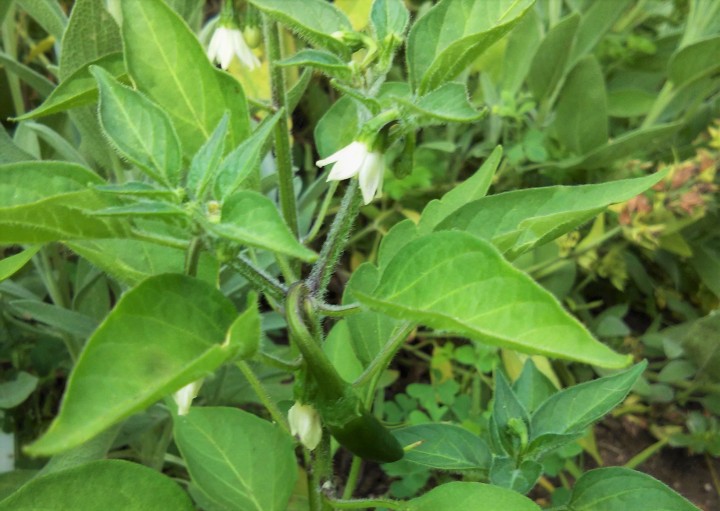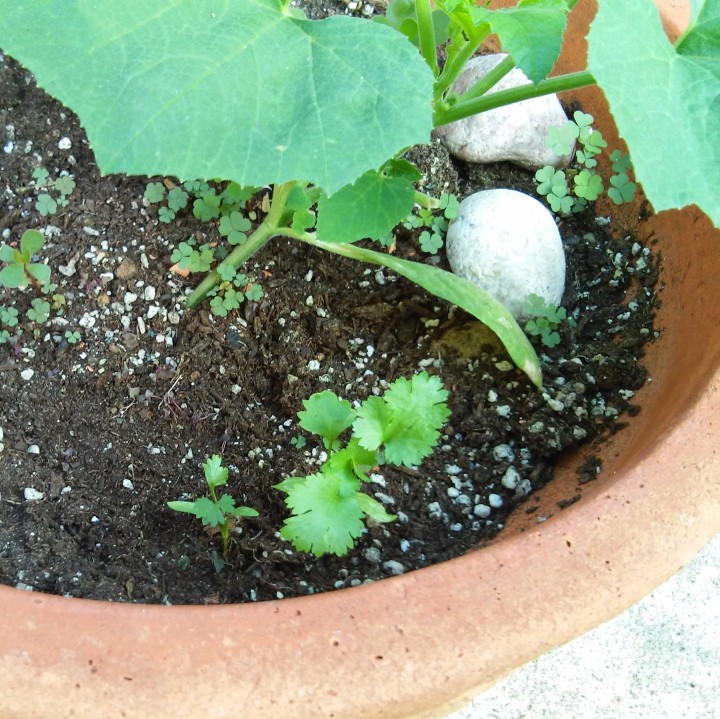
So far, it has been a very hot and generally dry summer in my area, but with regular watering and bug inspections, my garden seems to be doing well. Japanese beetles thrive in wet conditions, so thankfully they have not arrived full blast; however, as I was passing by the asparagus fronds, I noticed a couple of clumps of slug-like bugs:

Closer inspection revealed that they were asparagus beetle larvae, with the final confirmation from the presence of a few adults:

Asparagus beetles are black and red; some have six whitish spots on the back, and other are spotted, like ladybugs; I have seen both kinds. In this case they were easy to identify, since they had the white spots (left photo, below), but even the other kind are easy to distinguish from the helpful ladybugs (right photo), since the pesky asparagus beetles are elongated, and their heads stick out from their bodies, with long antennae, while ladybugs are almost circular, with no visible antennae:
Asparagus beetles must be controlled because they weaken the plants, which in turn are not able to store enough energy for next year’s growth. These beetles also have a very short life cycle, so they might become overwhelming if two or more generations have to be dealt with in one single season. Fortunately dislodging them with a gloved hand into a tub of soapy water took care of them without much of a kerfuffle, and I moved on to check on my tomatoes. All varieties seem to be growing fine, blooming and starting to grow green fruit:
Back in March, I had mentioned that I would be following up on three crops that are very helpful in the Mexican kitchen. The first two are serrano peppers and tomatillos, which are sometimes hard to find at the store. The serranos are blooming and growing fruit (close-up at the top of the post); pepper blossoms are so pretty! And each will grow a fiery and tasty pepper. There were a few holes on some of the leaves, probably from bug damage; spraying them with a solution of 1 tbsp Epsom salt dissolved in 1 liter of water will help prevent future attacks, and nourish self-repair. Other than that, they are growing well:

As for tomatillos, I planted 3 plants in full sun, and 2 in a spot with partial shade. The latter are growing slowly, they are just about 8-10 inches tall:

This would have made anyone woebegone, but fortunately the other three are blooming and about two feet tall, making clear that sun exposure is definitely an important factor when choosing a location for tomatillos (the same applies to tomatoes, eggplant and peppers):


The third featured crop is cilantro. As I also mentioned before, although it is usually easy to find at the store, cilantro is sold in bunches and may not last more than a week in the fridge, so it is convenient to have it in the garden, available on demand, and in small quantities. My cilantro is just appearing here and there now; I think the sudden swings in temperature have not helped the crop this year. I spotted two small plants in a pot next to the zucchini:

I will come back to these crops in a few weeks, when it is time to harvest, and hopefully post about some worthy-of-legend salsa recipe.












I tried buying serrano peppers a couple years ago, but they were mislabeled. I ended up with a ton of shishitos instead! Last year a nice bunch of poblanos. This year hopefully more of those and some jalapeños. It seems my cilantro always goes to see before I mange to use much. Any ideas?
LikeLike
I have never seen shishitos here, heehee, only the common hot green long Thai. I have only seen serranos once at stores around here, but now that I grow them, I have not looked back; I get more than enough from 3 or 4 plants each year. Fresh jalapenos are often close enough, although I prefer serranos for fresh salsas, and nothing beats a serrano “toreado” before frying next to a good steak, yum! Cilantro does better in early spring or late summer, and when it gets hot, it either goes to seed if it’s wet, or dies if it’s dry. I find harvesting consistently and partial shade helps a lot. I was surprised to see these sprouts this late (for Ontario), but it is probably because that pot gets sun mostly in the afternoon. On the bright side, green cilantro seed is a special treat in Thai cuisine, and dry seed is what we know as coriander, very useful in the kitchen.
LikeLiked by 1 person
I’ll never run out of coriander seed😆
LikeLiked by 1 person
🙂 heehee
LikeLiked by 1 person
Looks like your garden is growing well. Does Epsom salt also work on ants? I would like to move them out of my yard before I try corn again. They ate them all last year. And I only had 2 stalks.
LikeLike
I am not sure about ants, I think the Epsom spray throws little bugs off the leaves, and for ants, maybe makes their trail blurry. I think soapy water has the same effect and stays longer, sprayed along the lower part of the stacks and leaves, but don’t go too high because the bees and other pollinators need safe access in the case of corn. And I just read somewhere that bay leaves crushed around the base of plants helps, as well, I have to try it soon myself.
LikeLiked by 1 person